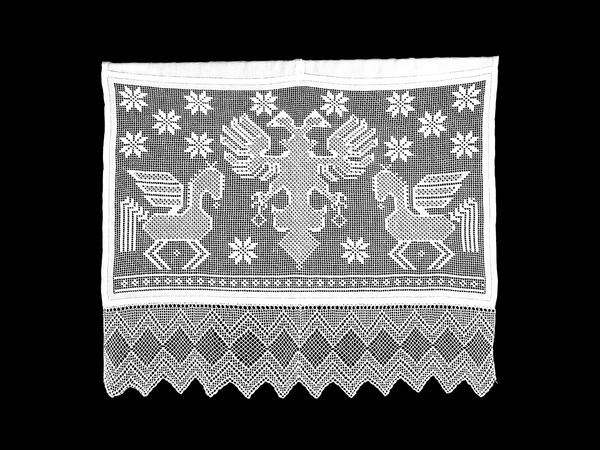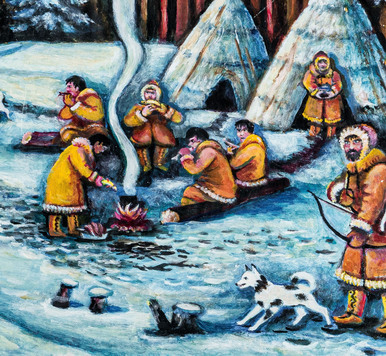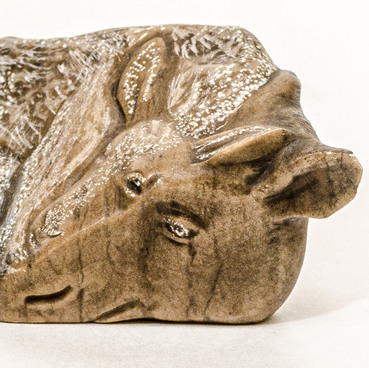Craftswoman Lydia Karandaeva was born in 1940 in the village of Uksyanskoye, Dalmatovsky District, Kurgan Region. In 1968, she graduated from the Kurgan Machine-Building Institute, then got a job at Kurganmashzavod as a design engineer in a special bureau.
Paganism
Время создания
1990
Место создания
Kurgan city
Размер
152,8x78,5 cm
Техника
linen, lace, white stitching, crocheting, drawn thread work
Коллекция
Выставка
1
Открыть в приложении#3
Lydia Karandaeva
Paganism
#16
#17
Lydia Karandaeva. Photograph: ‘Gamayun’ Museum Center
#18
Lydia Karandaeva decided to take up arts and crafts after she visited the exhibition of the ‘Kudesnitsa’ studio, which was run by Galina Dushkina, a famous craftswoman in the Trans-Urals. Soon after that, Karandaeva organized first a children’s studio, and a little later a studio for adults called ‘Slavyanskiy Dom’.
Lydia Karandaeva creates her works using the technique of white stitching. This method of lace making was brought to the Urals and the Trans-Urals by settlers during the industrial development of these territories. In this technique, threads are first drawn out of the material and a mesh is formed from the remaining ones. Depending on the density of the pattern, the squares can be sparse or dense. Then the craftswoman sews a pattern on top of them, making stitches close to each other or filling the space with an openwork cross-stitch.
Lydia Karandaeva creates her works using the technique of white stitching. This method of lace making was brought to the Urals and the Trans-Urals by settlers during the industrial development of these territories. In this technique, threads are first drawn out of the material and a mesh is formed from the remaining ones. Depending on the density of the pattern, the squares can be sparse or dense. Then the craftswoman sews a pattern on top of them, making stitches close to each other or filling the space with an openwork cross-stitch.
#19
Lydia Karandaeva at work. Photograph: ‘Gamayun’ Museum Center
#20
Karandaeva also embroiders with counted satin stitch — tight stitches that fit perfectly to each other. The craftswoman also uses color intertwined embroidery. To create a product using this technique, one needs to pull out some of the threads from the canvas, join the rest into groups and carefully twist them with colored threads so that one gets the design pattern.
In her works, Lydia Fedorovna uses traditional patterns, adding original details. She mainly embroiders household items: towels, napkins for joyful events, and tablecloths.
Embroidery of tablecloths with colored wool on a large black mesh has been a traditional ‘winter’ handicraft in the Urals for a long time. It helped women pass the time and sometimes make some money.
The towel ‘Solar Horses Guarding the God-given Power’ is a type of towel called ‘bozhnik’ (‘god’s towel’). Such elegant towels were used to decorate icon cases with home icons. In this embroidery, Lydia Fedorovna used images of solar horses and the Virgin’s stars, typical for towels of the 18th century. On a towel, they are combined with the modern symbol of Russian statehood — a two-headed eagle.
In her works, Lydia Fedorovna uses traditional patterns, adding original details. She mainly embroiders household items: towels, napkins for joyful events, and tablecloths.
Embroidery of tablecloths with colored wool on a large black mesh has been a traditional ‘winter’ handicraft in the Urals for a long time. It helped women pass the time and sometimes make some money.
The towel ‘Solar Horses Guarding the God-given Power’ is a type of towel called ‘bozhnik’ (‘god’s towel’). Such elegant towels were used to decorate icon cases with home icons. In this embroidery, Lydia Fedorovna used images of solar horses and the Virgin’s stars, typical for towels of the 18th century. On a towel, they are combined with the modern symbol of Russian statehood — a two-headed eagle.
#15
Ministry of Culture of the Russian Federation
читать дальшескрыть
00:00
00:00
1x
Paganism
Время создания
1990
Место создания
Kurgan city
Размер
152,8x78,5 cm
Техника
linen, lace, white stitching, crocheting, drawn thread work
Коллекция
Выставка
1
Открыть в приложении
Поделиться




